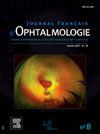Utilisation du smartphone pour l’examen du fond d’œil : une expérience auprès d’étudiants de deuxième cycle d’études médicales
IF 1.1
4区 医学
Q3 OPHTHALMOLOGY
引用次数: 0
Abstract
Objectif
Évaluer les performances d’étudiants de deuxième cycle des études médicales dans la réalisation d’une photographie du fond d’œil à l’aide d’un smartphone.
Matériel et méthodes
Au début de leur stage hospitalier, les étudiants ont reçu un enseignement dirigé portant sur la technique de l’ophtalmoscopie indirecte au smartphone, d’abord théorique puis procédural, avec un atelier de simulation sur un œil artificiel conçu à des fins pédagogiques. La technique impliquait un alignement manuel, sans support stable, de l’axe de la caméra du smartphone avec celui d’une lentille convergente de 20 dioptries. Ils devaient ensuite chacun examiner dix patients en consultation et obtenir une photographie du fond d’œil. Des questionnaires d’évaluation ont été complétés par les étudiants, les encadrants et les patients afin d’évaluer la performance de la technique d’examen.
Résultats
Entre septembre 2022 et avril 2023, 27 étudiants en médecine, stagiaires dans le service d’ophtalmologie du centre universitaire, ont participé à l’étude. Au terme d’un cycle d’entraînement de dix examens du fond d’œil, leur sentiment d’efficacité personnelle a significativement progressé, passant de 10,39/20 à 15,48/20, soit un facteur de 1,5 (p < 0,001). Sur le plan technique, la qualité du geste, telle qu’évaluée par l’encadrant, a significativement progressé, passant de 11/20 à 16,96/20, soit une amélioration d’un facteur de 1,5 (p < 0,001). La qualité des clichés et la durée d’examen se sont améliorées avec le nombre d’essais. À partir du neuvième fond d’œil, 80 % des clichés étaient exempts d’artéfacts.
Conclusion
Notre étude a montré que les étudiants étaient capables d’apprendre la technique de l’ophtalmoscopie indirecte au smartphone, d’abord en simulation, puis en pratique clinique, et d’améliorer significativement leurs performances, atteignant une qualité satisfaisante après dix essais.
Purpose
To evaluate the performance of medical students in learning funduscopy using smartphones.
Methods
Participants were medical students who were divided into small groups and taught the technique of smartphone funduscopy, first theoretically and then procedurally, with a simulation workshop on a model eye. The technique involved freehand alignment of the smartphone camera axes with a 20 diopter double aspheric lens. They then had to examine 10 patients in a retina clinic and obtain fundus photographs. Evaluation questionnaires were completed by students, supervisors and patients to obtain data on the performance of the examination technique. We aimed to investigate the effects of training on students’ self-rated technical skills.
Results
Between September 2022 and April 2023, 27 medical students completing their ophthalmology rotation at our university teaching hospital were enrolled in the study. At the end of a training cycle of ten fundus examinations, students’ self-efficacy scores increased significantly from 10.39/20 to 15.48/20, a factor of 1.5 (p < 0.001). On the technical level, the quality of the examination, as rated by the instructor, increased significantly from 11/20 to 16.96/20, a factor of 1.5 (p < 0.001). The quality of the images and the duration of the examination improved with the number of examinations. By the ninth funduscopy, 80% of the images were free of artifacts.
Conclusion
Our study showed that, by using a smartphone in a simulation and then in a clinical setting, students were able to learn and develop their skills in indirect ophthalmoscopy. Their smartphone funduscopy performance improved with training, achieving satisfactory quality after 10 trials.
用智能手机做眼部检查:医学研究生的实验
目的:评估医学研究生使用智能手机拍摄眼底照片的表现。设备和方法在他们的医院实习开始时,学生们接受了智能手机间接视镜技术的指导,首先是理论,然后是程序,包括一个为教学目的设计的人工眼睛模拟研讨会。这项技术需要在没有稳定支架的情况下手动对准智能手机的相机轴和20屈光度的收敛镜头轴。然后,他们每人检查了10名门诊病人,并获得了一张眼底照片。学生、护理人员和患者完成了评估问卷,以评估测试技术的性能。从2022年9月到2023年4月,27名医科学生、大学中心眼科实习人员参与了这项研究。经过10次眼底检查的训练周期后,他们的自我效能感显著提高,从10.39 /20提高到15.48 /20,即1.5倍(p <;0.001)。在技术层面上,由主管评估的手势质量有了显著提高,从11/20提高到16.96 /20,提高了1.5倍(p <;0.001)。随着测试次数的增加,图像质量和检查时间都有所提高。从第九眼开始,80%的照片都没有人工制品。结论:我们的研究表明,学生能够通过智能手机学习间接眼科检查技术,首先是在模拟中,然后是在临床实践中,并显著提高了他们的表现,在10次试验后达到令人满意的质量。目的:评估医科学生使用智能手机学习资金复制的表现。方法参与者是医科学生,他们被分成小组,首先在理论上,然后在程序上,通过一个关于模型眼睛的模拟研讨会,教授智能手机基金扫描技术。该技术涉及用20个屈光度双非球面透镜徒手对准智能手机摄像头轴。然后,他们必须在视网膜诊所对10名患者进行检查,并获得足够的照片。学生、主管和患者完成了评估问卷,以获得检查技术性能的数据。我们的目标是调查培训对学生自我评价技术技能的影响。结果:在2022年9月至2023年4月期间,有27名医科学生在我校教学医院完成眼科轮转。在10次资助考试的培训周期结束时,学生的自我效能分数从10.39/20显著提高到15.48/20,提高了1.5倍(p <;0.001%)。在技术水平上,由讲师评分的考试质量从11/20显著提高到16.96/20,系数为1.5 (p <;0.001%)。图像的质量和检查的持续时间随着检查的次数而提高。到第九次复制时,80%的图像都没有人工制品。结论我们的研究表明,通过在模拟中使用智能手机,然后在临床环境中,学生能够学习和发展他们的间接眼科检查技能。他们的智能手机funduscopy性能通过培训得到了改善,经过10次试验,达到了令人满意的质量。
本文章由计算机程序翻译,如有差异,请以英文原文为准。
求助全文
约1分钟内获得全文
求助全文
来源期刊
CiteScore
1.10
自引率
8.30%
发文量
317
审稿时长
49 days
期刊介绍:
The Journal français d''ophtalmologie, official publication of the French Society of Ophthalmology, serves the French Speaking Community by publishing excellent research articles, communications of the French Society of Ophthalmology, in-depth reviews, position papers, letters received by the editor and a rich image bank in each issue. The scientific quality is guaranteed through unbiased peer-review, and the journal is member of the Committee of Publication Ethics (COPE). The editors strongly discourage editorial misconduct and in particular if duplicative text from published sources is identified without proper citation, the submission will not be considered for peer review and returned to the authors or immediately rejected.

 求助内容:
求助内容: 应助结果提醒方式:
应助结果提醒方式:


